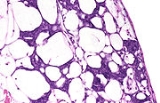
Blastema
Encyclopedia

Cell (biology)
The cell is the basic structural and functional unit of all known living organisms. It is the smallest unit of life that is classified as a living thing, and is often called the building block of life. The Alberts text discusses how the "cellular building blocks" move to shape developing embryos....
s capable of growth and regeneration
Regeneration (biology)
In biology, regeneration is the process of renewal, restoration, and growth that makes genomes, cells, organs, organisms, and ecosystems resilient to natural fluctuations or events that cause disturbance or damage. Every species is capable of regeneration, from bacteria to humans. At its most...
into organ
Organ (anatomy)
In biology, an organ is a collection of tissues joined in structural unit to serve a common function. Usually there is a main tissue and sporadic tissues . The main tissue is the one that is unique for the specific organ. For example, main tissue in the heart is the myocardium, while sporadic are...
s or body parts. Historically blastema have been thought to be composed of undifferentiated pluripotent cells, but recent research indicates that in some organisms blastema may retain memory of tissue origin. Blastemata are typically found in the early stages of an organism
Organism
In biology, an organism is any contiguous living system . In at least some form, all organisms are capable of response to stimuli, reproduction, growth and development, and maintenance of homoeostasis as a stable whole.An organism may either be unicellular or, as in the case of humans, comprise...
's development
Morphogenesis
Morphogenesis , is the biological process that causes an organism to develop its shape...
such as in embryo
Embryo
An embryo is a multicellular diploid eukaryote in its earliest stage of development, from the time of first cell division until birth, hatching, or germination...
s, and in the regeneration of tissues
Biological tissue
Tissue is a cellular organizational level intermediate between cells and a complete organism. A tissue is an ensemble of cells, not necessarily identical, but from the same origin, that together carry out a specific function. These are called tissues because of their identical functioning...
, organs and bone
Bone
Bones are rigid organs that constitute part of the endoskeleton of vertebrates. They support, and protect the various organs of the body, produce red and white blood cells and store minerals. Bone tissue is a type of dense connective tissue...
.
Some amphibians and certain species of fish can produce blastema as adults. For example, salamander
Salamander
Salamander is a common name of approximately 500 species of amphibians. They are typically characterized by a superficially lizard-like appearance, with their slender bodies, short noses, and long tails. All known fossils and extinct species fall under the order Caudata, while sometimes the extant...
s can regenerate
Regeneration (biology)
In biology, regeneration is the process of renewal, restoration, and growth that makes genomes, cells, organs, organisms, and ecosystems resilient to natural fluctuations or events that cause disturbance or damage. Every species is capable of regeneration, from bacteria to humans. At its most...
many organs after their amputation, including their limbs, tail, retina and intestine. Most animals, however, cannot produce blastemas.
When the limb of the salamander is cut off, a layer of epidermis covers the surface of the amputation site. In the first few days after the injury, this wounded epidermis transforms into a layer of signaling cells called the Apical Epithelial Cap (AEC), which has a vital role in regeneration. In the meantime, fibroblasts from the connective tissue migrate across the amputation surface to meet at the center of the wound. These fibroblasts multiply to form a blastema, which are the progenitors for the new limb.

